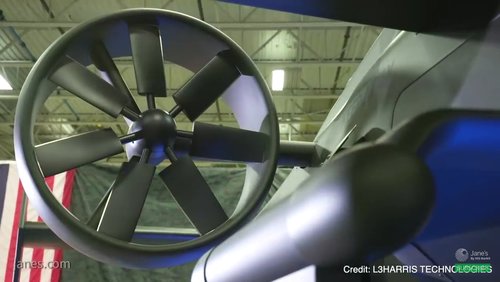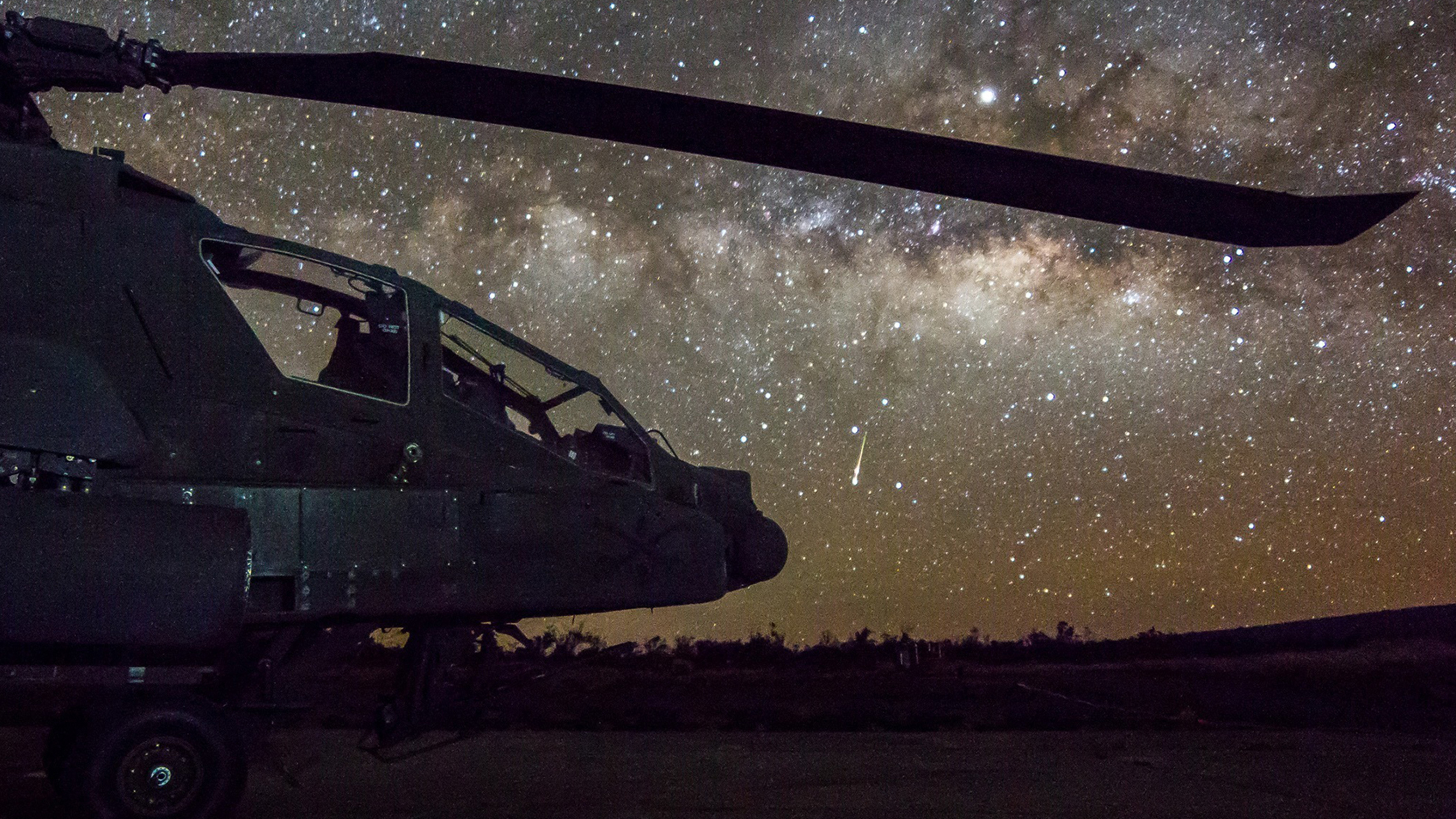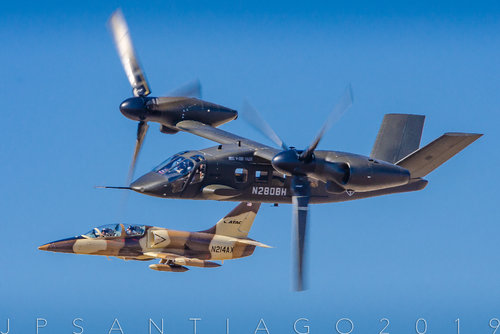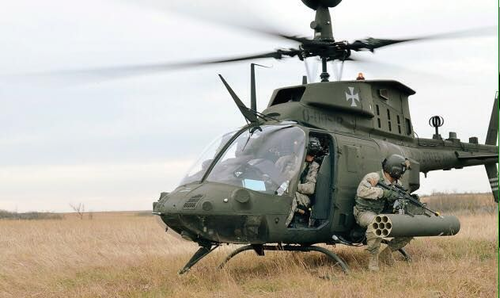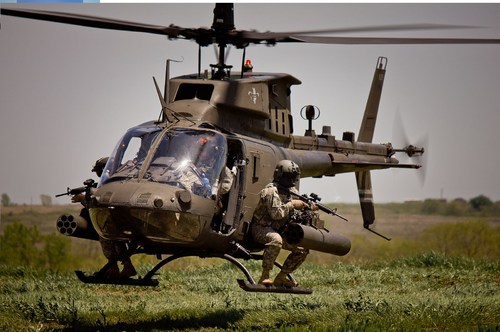Speed And Size Drive Advanced Options For U.S. Army’s Armed Scout
Oct 18, 2019
Graham Warwick | Aviation Week & Space Technology
The U.S. Army faces an array of options for its Future Attack Reconnaissance Aircraft (FARA). To meet the demanding size and speed requirements, four of the contenders have each unveiled different rotorcraft configurations. The fifth, Boeing, is keeping its design under wraps.
The Army’s requirements for a maximum speed of at least 180 kt. in an armed scout rotorcraft that can fit within a 40 X 40-ft. “box,” enabling it to fly between buildings in urban combat, is pushing manufacturers beyond conventional helicopter configurations.
Externally, Bell’s 360 Invictus is the most conventional of the offerings revealed so far, with a single main rotor and ducted tail rotor. But the design is optimized for high speed, with a low-drag tandem-seat fuselage, a wing to offload the rotor and a supplemental power unit to augment the single 3,000-shp-class General Electric T901 turboshaft to help push the helicopter to its 185-kt. top speed.
- Karem offers high-speed, active-rotor compound
- Sikorsky proposes derivative of coaxial-rotor S-97
AVX Aircraft, teamed with L3Harris Technologies, is proposing its Coaxial Compound Helicopter. This has side-by-side seating, a wing to offload the coaxial rotor and dual ducted fans for speed and agility. Details of Boeing’s design are sensitive, and the company does not want to give its competitors an edge, but the Army is fully informed on its initial design work says Mark Cherry, Phantom Works president.
Sikorsky is emphasizing growth capability to stay ahead of evolving threats with its FARA offering, the Raider X. Based on the X2 coaxial rigid-rotor compound configuration, the aircraft is a development of the S-97 Raider prototype now in flight-testing. The Raider X is about 20% larger, with a 14,000-lb. gross weight, compared to 11,000 lb. for the S-97, and a 39-ft.-dia. rotor, compared to 34 ft. for the Raider.
The Raider X will surpass the FARA program’s threshold of 180 kt. Sikorsky is not saying how fast it will fly but notes the S-97 has reached 215 and 207 kt. in level flight. This exceeds the 205-kt. target in the Army’s initial capability requirements document, says Tim Malia, Sikorsky’s director of future vertical lift-light.
The Army subsequently reduced the threshold maximum speed to enable a wider competition for the FARA program. But Malia says the greater speed and payload capability of the X2 configuration compared to a conventional helicopter provides growth capacity. “We looked at a single main rotor helicopter for FARA, but it would be minimally compliant in the early 2020s.
We need to be able to stay ahead of the threat into the 2030s and 2040s,” he says.
“Single main rotor will not be able to keep up. It’s already tapped out meeting the minimal FARA requirements. It does not have the ability to grow capability over time,” says
Malia. “We didn’t want to pull out all the stops to be minimally compliant when we had X2 able to carry more payload and go faster.”
The Raider X has four-blade rotors and a pusher propulsor. The coaxial rotors generate lift only on the advancing sides, eliminating retreating-blade stall and enabling higher speed. At high speed, 90% of the engine power goes to the propulsor, says Bill Fell, senior experimental test pilot. The propulsor is declutched at low speed to reduce noise.
The Raider X closely resembles the S-97 prototype, with side-by-side seating. Compared with tandem seating, this improves crew coordination and situational awareness, says Malia. “And we can do it aerodynamically because of the robust performance inherent in X2. We are not trying to get out every last ounce of drag.”
Behind the cockpit is a large internal weapons bay. Internal carriage of missiles and unmanned aircraft—which the Army calls air-launched effects (ALE)—is a FARA requirement, but Malia says the cabin-like volume of Raider X’s bay provides growth space for future, larger systems. “The minimum threshold works now, but what if in 2030 there are new ALE that can be decisive but can’t be carried?” he asks.
The Raider X is powered by a single T901—which will be government-furnished equipment to all FARA bidders. “We do not have an additional engine to increase speed,” Malia says. “We use the power available and have a solid design built around it. The T901 provides speeds out of the chute in excess of requirements, and as it improves we can take direct benefit.”
Sikorsky is using the industry-funded S-97 prototype to reduce risk for its FARA bid, conducting flight tests to validate models and optimize the Raider X design. This includes flying new rotor blades designed to reduce drag and vibration. “We are getting exactly the results the models said,” says Malia.
With two rotor systems and a propulsor, Sikorsky is paying close attention to the Raider X’s cost. “We have done a complete affordability analysis and design to cost. We are extremely confident we will come in under the cost goal,” he says.
Several divisions of parent Lockheed Martin are part of Sikorsky’s FARA team, Malia says, including Aeronautics, Missiles and Fire Control, and Rotary and Mission Systems. Swift Engineering will build the airframe if Sikorsky wins one of two FARA competitive prototype contracts scheduled to be awarded in March 2020. The Army flyoff is planned for 2023, with the first unit to be equipped by 2028.
Teamed with Northrop Grumman and Raytheon, Karem Aircraft is proposing a winged compound helicopter with an actively controlled main rotor, the AR40. “The hallmark feature is it can fly fast,” says Thomas Berger, Karem’s FARA program manager. “We go past the threshold requirement by about 20% and do it without any additional auxiliary propulsion on a single T901.” This implies a speed of about 215 kt.
Founded by Predator designer Abe Karem, the company is better known for its development of the Optimum Speed Tilt Rotor (OSTR). But the Army’s requirement that FARA fit within a 40 X 40-ft. box ruled out a tiltrotor design. The designation AR40 stands for “40-ft. active rotor.”
The AR40 has a single main rotor, wing and a unique swiveling tail rotor, which provides anti-torque control at low speed but swivels aft to provide propulsion for higher forward speed. “This is the best design we know to attack the requirement. It has low drag and low vibration at high speed,” Berger says.
In a conventional rotor, a swashplate and pitch links mechanically transmit cyclic and collective blade-pitch command to the rotor head. In Karem’s active rotor, the blades are individually controlled by electric actuators in the hub. This allows blade pitch to be precisely controlled to maximize performance and minimize drag and vibration at high speed, says Berger.
Additionally, power for the full-authority individual blade control actuators is generated in the hub, says Berger, eliminating the need for slip rings to transfer electrical power to the rotating rotor. The rotor has three stiff, lightweight blades and a rigid, hingeless hub. The lack of a swashplate and pitch links results in a slim pylon between fuselage and rotor, reducing drag.
To achieve high speed, “we reduce drag significantly and unload the rotor to the wing,” says Berger. “The swiveling tail rotor means we do not have the edgewise drag of a tail rotor. We store all the ordnance inside, stow the gun and fair the targeting turret.” The AR40 has side-by-side seating. This improves crew coordination and provides additional room behind the cockpit for mission equipment or a cabin for personnel. “It’s space for free,” he says.
While no active rotor has progressed beyond the R&D stage yet, Karem is developing the component technology under the Army’s Joint Multi-Role Technology Demonstration (JMR TD) program. Under this program, the company will ground-test a 36-ft. variable-speed active rotor for its OSTR design for the Army’s planned Future Long-Range Assault Aircraft.
The OSTR uses the same active control, lightweight blade and rigid hub technology as the AR40. The JMR TD rotor “is under component test, with the integrated test next year,” says Berger. “It will directly help reduce risk for [the AR40’s] individual blade control, rigid hub, blades, etc.”
Karem has worked with the Army’s science and technology community for many years, first on Joint Heavy Lift and later on JMR TD, but the company is still a relative unknown, so it has teamed with heavyweight partners Northrop for airframe production and Raytheon for the open-architecture mission system.
“Karem is the driving pioneer of the rotor and drive system.
Northrop Grumman brings full OEM production and support capability,” Berger says. Northrop company Scaled Composites is also involved and will likely build the prototype if the AR40 wins one of the two competitive prototype contracts.
Northrop Grumman Mission Systems will provide the avionics and cockpit integration. Raytheon will perform mission-system integration using its experience with modular open-architecture systems. “We have teamed with big OEMs who have the ability to provide managed risk,” says Berger.
—With Lee Hudson in Washington

